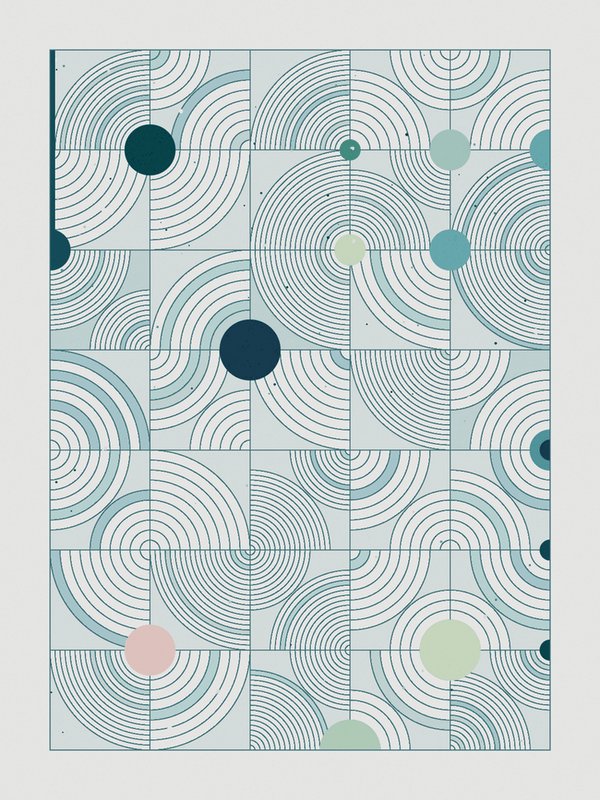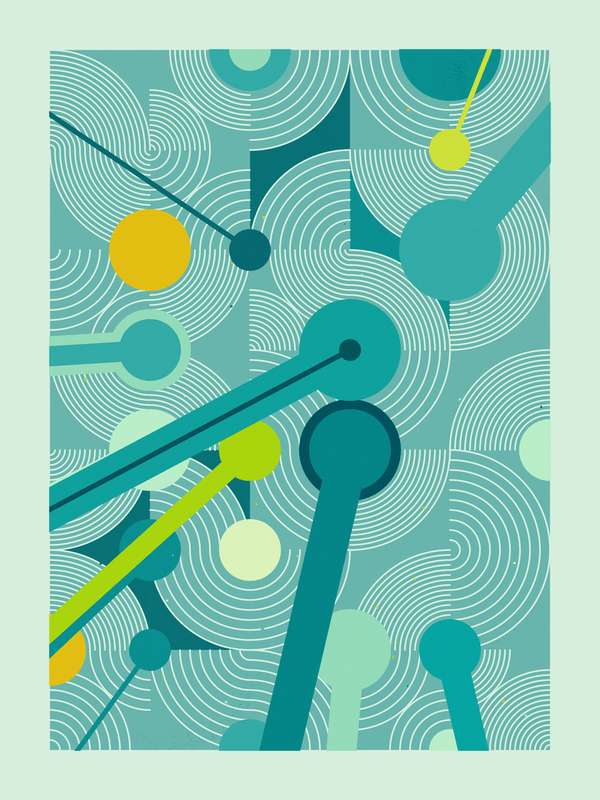Forecast
November 15th 2023 - Art Blocks
Forecast abstractly captures the essence of rainfall on a stone-paved road while drawing an analogy between weather and human emotions. It explores the emotions rain can evoke, comparing the unpredictability of weather with the shifting range of human feelings.
The code recreates a weather forecast to determine where on the canvas rain will fall. It simulates barometric pressure and humidity to alter a circle-packing algorithm that acts like clouds over the canvas, calculating the probability of precipitation for each piece and distributing rain in a visually appealing way.
Geometry, color, and natural forces work together to create an abstract representation of rain that pays homage to where I was born, 'Galicia, where rain is art'.
The concept
In the northwest of Spain lies Galicia, a region where rain holds a special place.
With approximately half of the year consisting of rainy days, it's no surprise that the Galician language has evolved to encompass a rich vocabulary of over 100 words to describe its various forms and moments. Rain has become an art form in our everyday lives, expressed through our language and the nuances of our conversations.
-
Our lexicon starts with the simple word 'chuvia', derived from Latin, and expands to capture the intensity and diverse nature of rain. From the drizzling 'orballo,' 'chuvisca,' and 'barruzo' that seep into our bones unprepared, to the fine and persistent 'poalla' or 'poalleira' that we brave without seeking cover, our language vividly portrays the different shades of rain.
As the intensity of rainfall increases, we encounter words like 'treboadas' or 'torbóns,' 'xistra,' 'arroiadas,' where water flows with force or intermittent 'chuvieiras.' On occasions, we experience heavy rainfall, known as 'caldeiros,' 'xerros,' or 'batega'.
Our vocabulary is meticulously crafted to capture even the slightest variations and forms of rain, including intricate details, such as if a rain is so thin that floats in the air while there is sunlight and there are visible white drops, called 'froallo', unique names based on the sound rain makes as it touches the ground, and even different terms for rain lasting beyond a single day 'ballón'.
Fortunately, rain in Galicia always ceases eventually, bringing us joy. We express this moment with words like 'escampa,' 'escambra,' 'delampa,' or 'aliva.' But as Galicians, we carry the rain inside ourselves and cannot stop talking about it, even on sunny days.
When recalling a distant memory, we say 'xa choveu desde aquela' (it has rained since then), and in the face of a problem, we assert that 'nunca choveu que non escampase' (it never rained and didn't clear). If we are indifferent to something, we state 'por nós que chova' (we don't care if it rains). When things are unpredictable, we say 'se chove que chova' (if it rains it rains), meaning whatever happens, everything will be fine."
It was within this setting of rich traditions and linguistic nuances that inspiration took hold on a rainy Sunday afternoon, as I wandered through the old part of town, captivated by the movement of raindrops and mesmerizing water ripples on the stone-paved road, nurtured by the deep connection between Galicia's cultural heritage of intricate vocabulary of rain.
This intriguing interplay between weather and language extends far beyond Galicia, languages like Japanese, Welsh, and even Hawaiian bear witness to this captivating phenomenon, where weather molds the very fabric of our linguistic expressions. It serves as a testament to the profound influence of weather on our collective human experience.
Immersing myself in research, I embarked on a journey of simplification, distilling everything to its core. It allowed me to delve even deeper into the artistic contributions of Rudolph de Harak, particularly his 1960s book covers characterized by their modernist aesthetics. I also immersed myself in the creative world of American minimalist Frank Stella and embraced artistic movements like Constructivism, Bauhaus, and Swiss Design. These movements, renowned for their minimalist principles, often deconstructed artworks to their most fundamental elements. Geometry provided an avenue for further exploration and inspiration, eventually taking on a life of its own.
While rain and weather influencing language ignited my inspiration, I sought to explore further, embarking on a creative journey that explores the profound impact rain has on emotions and feelings—a shared human language that transcends borders and requires no translations.
Drawing from the linguistic richness of Galicia and its deep connection to rain, 'Forecast' pays tribute to the beauty of rain and its profound influence on human emotions. It goes beyond the visual appearance of rain and delves into the range of emotions it evokes, surpassing the common perceptions of melancholy and introspection. Rain can also evoke a sense of joy, happiness, and even renewal and rebirth.
To express the diverse range of emotions rain can evoke, I created color palettes inspired by personal memories and experiences, capturing the essence of how those moments, events, and places made me feel. To further enhance the expression of emotions, I use size and proportion symbolizing and amplifying the intensity of those feelings. This approach brings forth the emotional impact of rain in our lives, inviting viewers to reflect on their own relationship with rain and the feelings it evokes in them.
To add depth and significance to its compositions “Forecast” creatively simulates a weather forecast, incorporating barometric pressure and humidity – variables that dynamically influence a circle packing algorithm that symbolizes clouds over the canvas, generating the necessary data to calculate the probability of precipitation for each piece and distribute rain on the canvas in a visually appealing way. The result is a perfect balance between randomness and control that added an extra layer of depth to the artwork.
Geometry, color, and natural forces work together to create an abstract representation of rain that pays homage to where I was born – Galicia, where rain is art.
Stone-paved roads
I created a versatile grid to represent the stone-paved roads, with varying tile sizes that can range from highly regular and structured to more irregular and chaotic, providing a flexible and adaptable starting point as the base for each piece generated.
Water ripples
To represent the water ripples on the stone tiles, I created a collection of unique drawings. The tiles themselves may either be square or rectangular and depending on their shape, they can accommodate varying designs of ripples. Each of these drawings can be oriented in four different directions, allowing for even greater flexibility and variation.
Regardless of the size or position, the water ripples depicted on each tile are designed to seamlessly connect with those of any adjacent tile. This ensures that the overall effect of the ripples if connected, is not disrupted and creates a cohesive and harmonious visual experience.
Ripple density & stroke width
There are three different “densities” that “Forecast” can display. These control the spacing of ripples on the tiles.
These 3 densities can also be mixed, each tile having a different density that connects to other tiles with a different one.
The different options are:
High density (1)
Medium density (2)
Low density (3)
Mix of High and Medium densities (1+2)
Mix of Medium and Low densities (2+3)
Mix of High, Medium, and Low densities. (1+2+3)
There are also 5 different stroke widths possible.
Raindrops
Each different ripple pattern has different spots where a raindrop can fall. Depending on the size of the tile and the density of the ripples, the drops can be different sizes. When 2 tiles with opposite spots are next to each other there is a chance there will be two or more drops in the same coordinate in the canvas.
Rain & wind direction
The next step is adding the visible rain streaks. These lines follow the wind direction. There are also 2 special wind directions if the weather conditions match a certain level, Hurricane and Focus.
Wind can come from any direction:
South (S)
Southwest (SW)
West (W)
Northwest (NW)
North (N)
Northeast (NE)
East (E)
Southeast (SE)
Hurricane
Focus
Rain can also have 2 different styles:
Straight
Curved
Probability of precipitation
As I was building and testing, I realized that simply adding random spots of rain to the canvas wasn't creating interesting compositions. I needed a visually appealing way to control the distribution of rain, which led me to the idea of using a circle-packing algorithm. This algorithm allowed me to distribute rain across the canvas in a more controlled and captivating manner.
As I experimented with the circle-packing technique, I realized that it resembled clouds, inspiring me to explore the concept further. While researching at the National Weather Service, I came across the 'Probability of Precipitation' (PoP) equation, which became a pivotal inspiration and lead me to creatively recreate a weather forecast.
The chance of precipitation or "Probability of Precipitation" (PoP) is a term used by meteorologists to help clients or viewers get an understanding of how likely a specific area is to see rain. Determining the PoP is an equation (Forecaster Confidence x Areal Coverage = PoP).
- National Weather Service ( www.weather.gov )
To incorporate this equation into my artwork, I used barometric pressure to control the distance between the circles. Lower pressure values result in closer circles. Additionally, I used humidity to determine the maximum and minimum sizes of the circles. By combining these variables they dynamically influence the circle-packing algorithm to generate the necessary data to calculate the PoP and assign a probability of precipitation to each piece.
This approach provided a harmonious balance between randomness and control. With this newfound level of control, I not only create visually appealing compositions but also embedded the concept of a weather forecast directly into the artwork's code, adding an extra layer of depth to the artwork.
Color palettes
To express the diverse range of emotions rain can evoke, I created 16 color palettes inspired by personal memories and experiences, capturing the essence of how those moments, events, and places made me feel.
Color palettes:
Muddy mondays
Isas
Galicia
Introspection
Unforgettable Summers
Happy Sunset
Sarasota
Allnighter
Memories
Rhapsody
Rain or Shine
Melancholy
Gloom
Umbrella Bonding
Monday
Tuesday
9- Memories
10- Rhapsody
11- Rain or Shine
12- Melancholy
13- Gloom
14- Tuesday
15- Umbrella Bonding
16- Monday
1- Isas
2- Galicia
3- Introspection
4- Muddy Mondays
5- Unforgettable Summers
6- Happy Sunset
7- Sarasota
8- Allnighter
Test outputs
Forecast is a collection of 365 unique iterations, all created from a single algorithm. The beauty is that every time a collector mints an artwork, the code randomly generates a completely new piece that not even the artist can know in advance. The gallery below showcases test outputs that are not part of the collection, but they provide a glimpse into the algorithm's capabilities.
If you enjoyed this project, please follow me and share it






























































































































































































